Table of Contents
ToggleIntroduction
In this huge benchmark roundup, I want to show you which level of performance you can expect from different boards and chipsets, when Socket A is the platform of choice. Especially in high-end Voodoo 5 retro systems, Socket A boards with the VIA KT333 chipset are very common.. But what about the older chipsets? Are they any good? And is Socket A a good Voodoo 2 platform as well? If you've always wanted to know how the VIA KT266A performs compared to the AMD 750 Irongate, or the SiS 735 compared to the ALi MAGiK 1 with their respective final BIOS versions and drivers, then this one is for you.
I primarily wanted to include every completely “retro-friendly” (with support for AGP 3,3V) Socket A chipset up to the VIA KT266A, but I also included the vanilla nVidia nForce, which extends the chipset manufacturers alone (!) to a total of five. The nForce “1” got a bit buried in the long history of the platform and not many motherboard models featuring nVidia's first motherboard chipset were released. Its successor, the nForce2/Ultra/400, became the standard chipset for Socket A, completely overshadowing its older brother. This makes it an interesting addition to the roundup, although it is not compatible anymore with older 3,3V graphics cards.
By the time of writing, this comparison includes 23 motherboards of that era, for each of which you can find a complete review on this site, if you are interested in a certain model of this roundup. Just search for the specific board in the site's global search or for "socket a review" to get a list of all reviews. I also included two VIA KM266 boards (which are interesting for smaller, retro-friendly Socket A builds) and one VIA KT333 board (as the presumed fastest retro-friendly Socket A chipset) to round things up.
The Colours
Before we get into the benchmarks themselves, a quick explanation on the colours of the bars found in the graphs:
The motherboards featured here run the CPU used in this review at speeds ranging from 1194 MHz all the way up to 1211,9 MHz, which is due to variations in the factory-defined FSB clockspeed at settings of 100 / 133 MHz. To make this visible in the graphs, I used different colours:
Below ~1196 MHz: dark blue
~1197 - ~1198 MHz: light blue
~1199 - ~1200 MHz: dark green
~1201 - ~1202 MHz: light green
~1203 - ~1204 MHz: yellow
~1205 - ~1206 MHz: orange
1207 MHz and up: red
With this out of the way, let's get into it!
Test-System and Parts
Hardware
- CPU
AMD Athlon Thunderbird 1200B (FSB100) for FSB100 capable chipsets
AMD Athlon Thunderbird 1200C (FSB133) for FSB133 capable Systems
- RAM
Default for DDR: 1x Corsair CMX512-3200C2 (XMS3202v4.2) = 512MB PC400 CL2
Default for SDR: 1x “Infineon 3rd” 512 MB PC133 SD-RAM
Shuttle AK32 SDR: 1x Kingston Value 512 MB PC133 CL2
nForce Dual Channel DDR: 2x Kingston Hyper X KHX3200/256 = 2x 256MB PC400 CL2
AMD751 + VIA KT133: 1x Infineon 256 MB PC133 CL2 + 1x Infineon 256MB PC133 CL3 SD-RAM sticks
- Graphics Cards / Accelerators
MSI Geforce 4 TI4200-VTD8X 128MB AGP
3dfx Voodoo 5 5500 64MB AGP
2x Voodoo 2 12MB (SLI)
- Storage (for IDE Performance and PCI Bandwidth Tests)
Silicon Image Sil3512 SATA Controller with Samsung PM871 128GB SSD
Hitachi Deskstar T7K500 (500GB 7200RPM IDE)
Software
- Chipset
ALi AGP 2.30 (ALi MAGiK 1)
AMD Integrated Driver 1.30 (AMD750)
AMD AGP Miniport 4.80 + VIA Hyperion 4in1 4.56v without AGP drivers (AMD761 + VIA 686B)
VIA Hyperion 4in1 4.35v (Gigabyte GA-7ZXR)
VIA Hyperion 4in1 4.56v (all other VIA based boards)
nVidia nForce driver 2.41 (nForce "1")
SiS AGP v1.21 + SiS IDE v2.04a (SiS 735)
- Graphics
nVidia Forceware 43.45 (Geforce 4)
Amigamerlin 2.9 (Voodoo 5)
FastVoodoo 4.6 (Voodoo 2)
- OS
Windows 98SE (Ger) + Unofficial SP 2.1d
DirectX 9
Benchmarks
Synthetic Measurements
Before we get into the 3DMark and gaming benchmarks, let's have a look at some theoretical numbers. These synthetic tests will exhibit the differences between the several chipsets and boards better than any game benchmark and provide us with "background information" that might be of use in understanding the timedemo results later.
Some motherboards show up twice in the results - this occurs when a board can be run with different memory configurations (SDR / DDR, single / dual channel) or has a 1/5 divider for FSB166. In some tests (AGP and PCI bandwidth, storage performance) I excluded the results with the higher FSB speeds as well as the slower memory configurations of the respective boards. In these tests, each board appears "only" once.
Memory Performance: AIDA64 Cache & Memory Benchmark
The AIDA64 Cache & Memory Benchmark tests the memory read and write throughput, as well as memory latency of the boards and gives a good overview how the performance developed in this department with the evolution of Socket A chipsets. It will also be interesting to see, how motherboards with identical chipsets compare to each other with their respective final BIOS versions installed.
Especially for the latency test, keep in mind that boards with factory-overclocked FSBs (yellow to red) have an advantage here and boards with a slight underclocked FSB (blue-ish) have disadvantages. If a board doesn't offer the fastest memory timings to be set (CL2 2-2-5 and below), it will also have problems here.
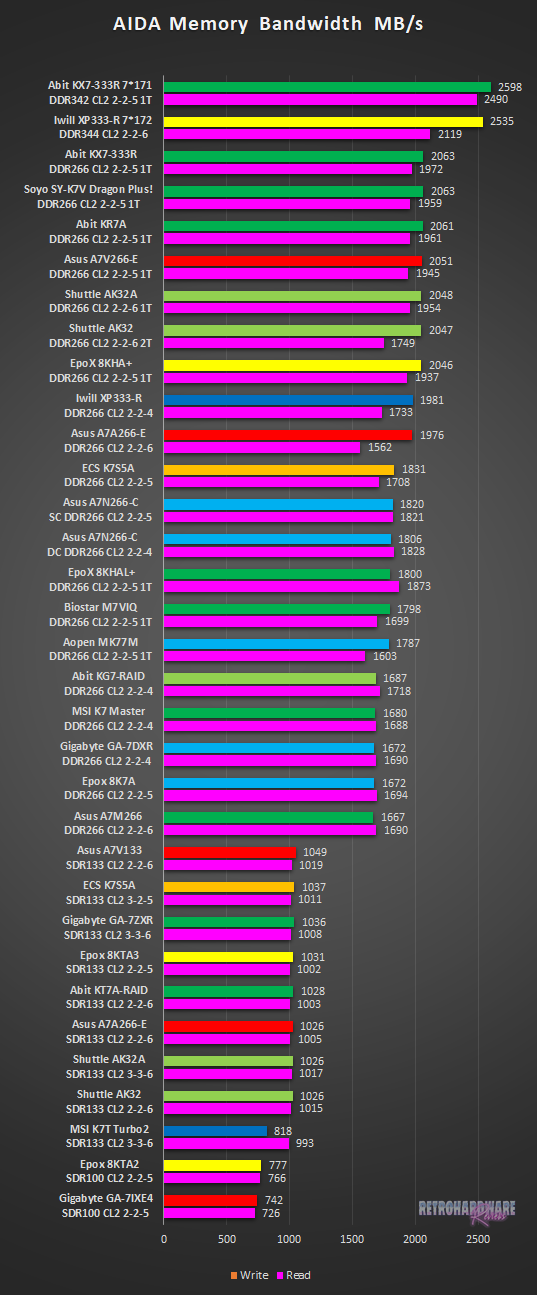
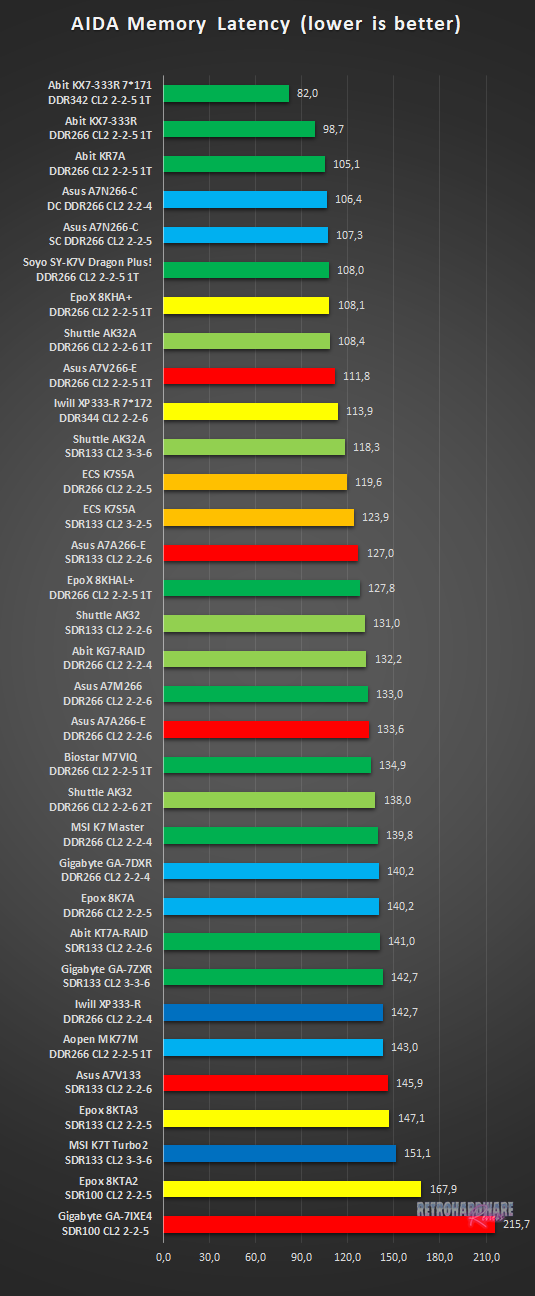
Starting at the top, the first interesting fact is, that the IWill XP333-R can almost match the write throughput of the Abit KX7-333R with the much newer VIA KT333 chipset, when both run at raised FSB speeds. The read throughput of the KX7 @ 171 MHz FSB, however, is completely out of reach.
At FSB133, Abit's KT333 board is only slightly faster in read throughput than the fastest KT266A-based boards, namely Soyo's K7V Dragon Plus! and the Abit KR7A-RAID. The write throughput is essentially identical to these boards.
The next interesting duel is between the two Shuttle boards. While the write performance of the boards is identical, the 1T Command Rate setting of the KT266A seems to massively boost the read performance over the KT266 based AK32.
Our two KM266 based participants perform notably worse than the full-size KT266(A) boards in the test and are more in the range of the AMD760 based boards, with a little advantage in write throughput.
All the FSB133 SDR memory results are fairly even (with the exception of the poorly performing MSI K7T Turbo2). The newer chipsets seem to have no advantage in memory throughput over the VIA KT133A, which was the first FSB133 capable Socket A chipset with this type of memory.
This is not true for memory latency though. In this respect, the boards based on the KT133A are clearly inferior to those based on the newer chipsets. The Abit KT7A-RAID and Gigabyte GA-7ZXR, which are the KT133A boards with the lowest memory latency, are at least in the range of some slower AMD760-based boards. The fastest boards with AMD's DDR chipset, such as the Abit KG7-RAID, are around the level of the ALi MAGiK 1 and VIA KT266 (SDR), represented by the Asus A7A266-E and the Shuttle AK32.
Elitegroup's K7S5A with the SiS 735 shows another notable improvement in latency over the previous chipsets, but everything beyond that is VIA KT266A territory. The only other chipset with comparably low latency (or even lower compared to most KT266A boards) is the nForce "1", represented by the A7N266-C, as well as the FSB-overclocked IWill XP333-R with the ALi MAGiK.
At the top of the list is the only KT333 board in the test, which even at 133MHz FSB has significantly better memory latency than the Abit KR7A-RAID, which is the fastest KT266A board.
Application Performance: 7-Zip
The 7-Zip 3.13 internal benchmark was done using an 8MB dictionary. This bench requires overall good system performance and is an interesting “real world application benchmark” in my opinion.
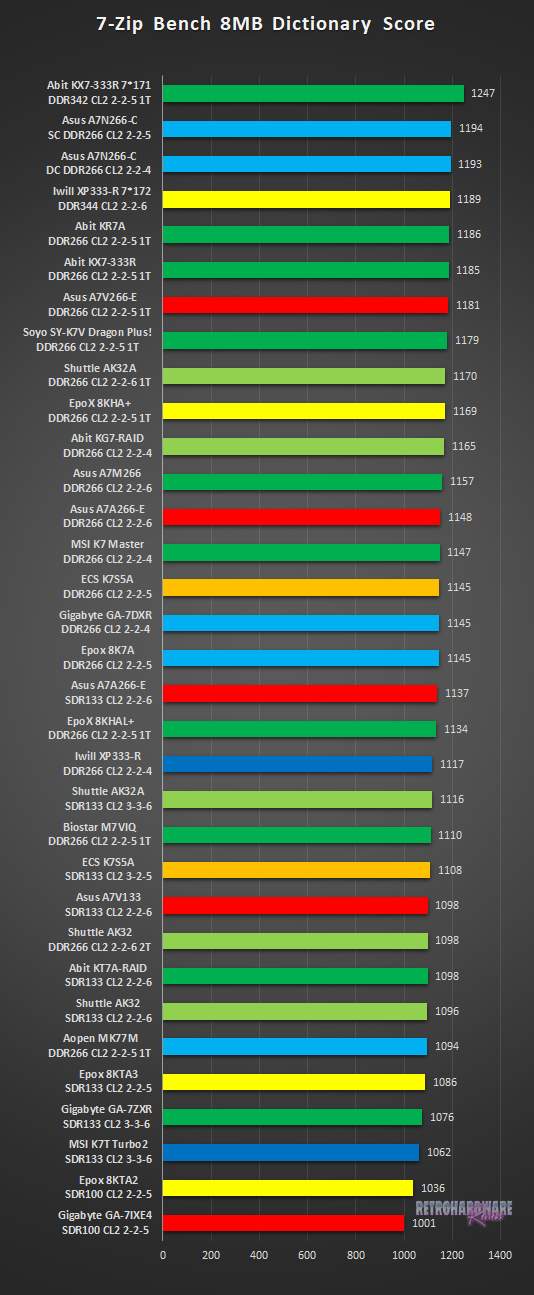
The A7N266-C with the nForce chipset dominates the 7-Zip bench and is even slightly faster than the XP333-R with overclocked FSB. The only board that scores higher is Abit's KX7-333R with the VIA KT333 chipset and an increased FSB of 171 MHz.
With a stock FSB of 133 MHz, the KX7-333R is no faster than its direct predecessor, the KR7A-RAID, which is the fastest KT266A-based board in the test. All KT266A boards, with the exception of the slower EpoX 8KHAL+, come next, followed by the fastest AMD760-based boards, the Abit KG7-RAID and the Asus A7M266.
The AMD chipset seems to work well in this benchmark, even the slower boards with this chipset match the best results of ALi MAGiK 1 and SiS 735 based boards.
Shuttle's AK32, the only KT266-based board in the test, lags far behind all other DDR chipsets and is only in the range of the fastest KT133A-based boards.
The two KM266 based boards disappoint once more. The Biostar board is only slightly faster than the K7S5A with SDR memory, but at least scores higher than all the KT133A boards and the AK32. AOpen's KM266 board, however, ranks behind the said Shuttle board and is also slower than the A7V133 and KT7A-RAID, both of which use the VIA KT133A chipset.
AGP Performance: Final Reality Benchmark
The Final Reality benchmark from 1997 has the interesting option to measure the AGP bandwidth fast and easily. Here are the results for both GeForce 4 and Voodoo 5:
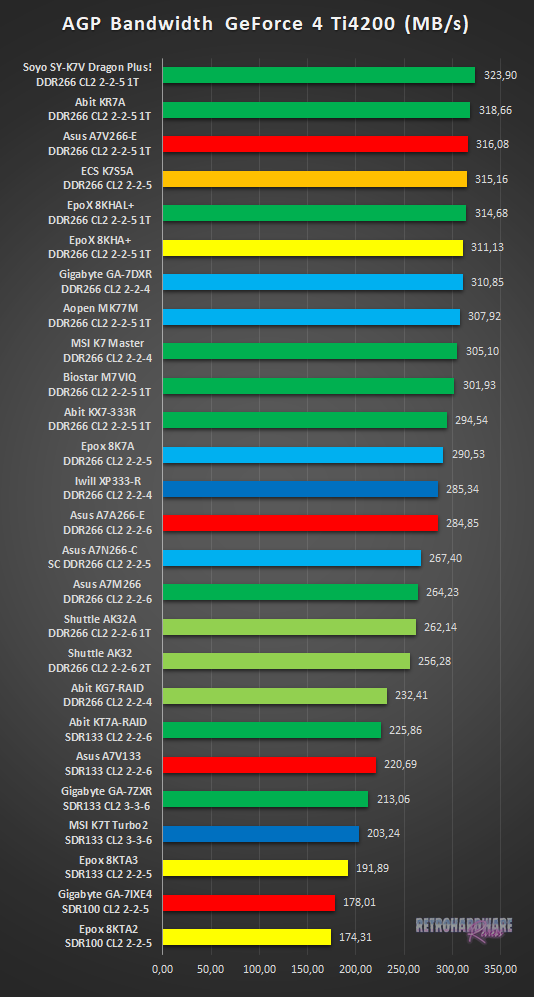
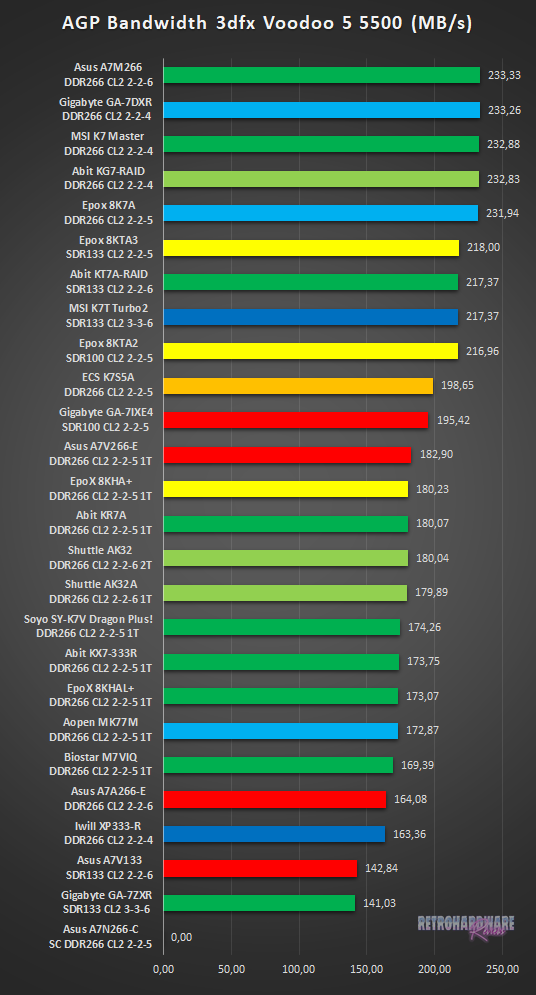
The old SDR chipsets (AMD750, VIA KT133/A) show the lowest AGP bandwidth with the nVidia card, most of the boards with the newer chipsets show massive improvements over the older boards.
Focusing on the exceptions to this rule, the first eye-catching result is that of the Abit KG7-RAID. While most boards with the AMD760 are around or above the 300 MB/s mark, the KG7-RAID shows only a slightly higher bandwidth with the GeForce 4 Ti, than Abit's KT133A board, the KT7A-RAID.
Another astonishing result comes from the Asus A7N266-C. With an nVidia chipset that was launched practically at the same time as the GeForce 4 Ti line of cards, I would expect fabulous results here, but the achieved bandwidth is only just under 270 MB/s. This is way less than achieved by all but one KT266A based boards in the test, which was the directly competing chipset at the time.
The mentioned exception among the KT266A boards is the Shuttle AK32A, which even achieves 5 MB/s less of bandwidth than the A7N266-C does.
Five of the top ten boards are based on the VIA KT266A chipset and all of the ten boards achieve more than 300 MB/s of bandwidth in the test.
Coming to the Voodoo 5 measurements, the first thing to mention is the overall lower AGP bandwidth level. The AMD760 chipset seems to work best with the 3dfx card in this regard, as all of the five boards with this chipset achieve by far the highest bandwidth with it.
The older chipsets generally seem to be the best choice for the Voodoo 5 in terms of AGP bandwidth. Directly after the AMD760 follow various VIA KT133/A boards, which also show very good results with the card. Even the GA-7IXE4 with the ancient AMD750 chipset and its legendarily bad AGP implemetation, shows bandwidth on the level of the K7S5A and above any VIA DDR chipset.
The ALi MAGiK 1 chipset seems to be the chipset with lowest AGP bandwidth when combined with the Voodoo 5.
It is very interesting to see, that with the Voodoo 5, you can practically say per chipset, whether its AGP implementation works good or bad with the card in terms of bandwidth. The only two exceptions to this rule are the KT133A based boards from Asus and Gigabyte, which show way lower bandwidth with the 3dfx card, than all the other boards with this chipset and are at the bottom of the list.
AGP and PCI Performance: 3DMark 2000 and ATTO
3DMark 2000 as a whole is very focused on TnL and is by far not as interesting for retro-hardware comparisons as its predecessor. Its “High Polygon Count, 1 Light” test, however, is another good way to measure the AGP performance. In opposite to the Final Reality test, the general system performance is also somewhat of importance. The benchmark was executed with the GeForce 4 Ti installed.
To measure PCI performance, I installed a Windows 98SE compatible SATA controller with a Samsung PM871 128GB SSD connected into the system. For the bench, I chose 1024 to 4096 KB block size and picked the overall best values for the read and write throughput. This test will show, which maximum performance can be expected with fast storage options like SATA or SCSI and maybe gives a hint, if the chipset might be good for Voodoo 2 cards.
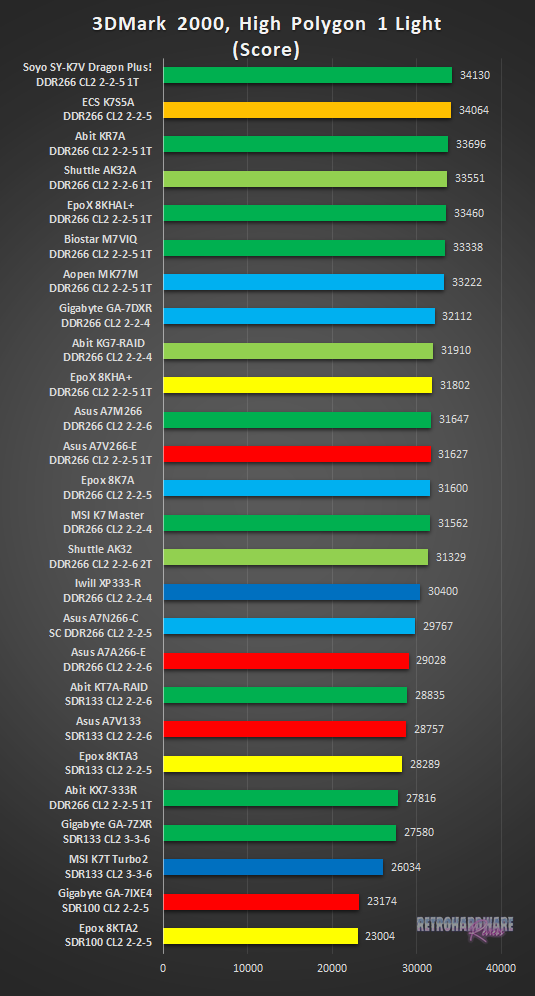
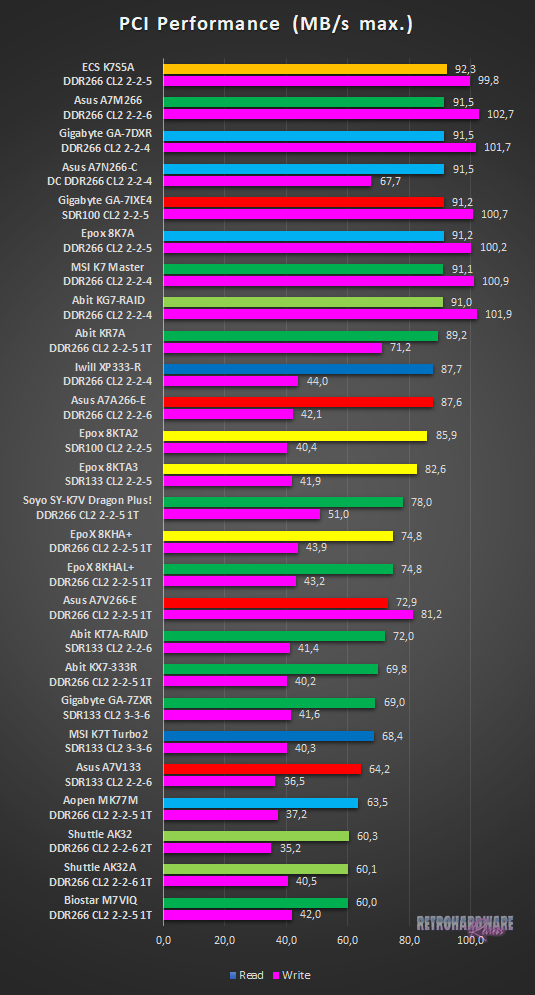
Note: The Abit KX7-333R was unstable with FSB171 in combination with the GeForce 4 in 3DMark99max as well as 3DMark2000, so AGP speed had to be downgraded to 2x.
Soyo's K7V Dragon Plus! ranks first in the 3DMark2000 sub-test, slightly ahead of the K7S5A. In the range of 34xxx to 33xxx points, there are only boards with VIA's KT266A and KM266 chipset, besides the Elitegroup board.
In the 32xxx to 31xxx range, we find all the AMD760 based boards as well as the AK32 with the KT266 and two KT266A based boards. One of the latter is the A7V266-E, which achieved the third highest result in the Final Reality AGP bandwidth test. Now, it performs only on the level of Asus' own AMD760 based board, despite tighter memory timings and a slightly overclocked FSB.
In the small group of boards performing around 30xxx to 29xxx points, we find the ALi MAGiK 1 boards from Asus and IWill, as well as the A7N266-C with the nForce. Beginning with 28xxx points and below, there are all the SDR-only boards, as well as Abit's KX7-333R, which had stability problems in both 3DMark benches and thus was throttled to AGP 2x speeds.
The results of the PCI bandwidth measurement look somewhat chaotic, as the ranking is sorted by read performance and the different chipsets have very different characteristics in terms of read versus write performance.
The AMD chipsets (AMD750 and AMD760) domitate here, with excellent bandwidth for both, reads and writes. The ECS K7S5A with the SiS735 shows very comparable performance (and characteristics) and takes first place, with a slight lead in read performance over the other boards.
The A7N266-C is also very high in the list, because of its read throughput. Its write performance, however, is noteably worse with around 68 MB/s.
Abit's KR7A-RAID ranks ninth with slightly lower read but higher write performance than the nForce, making it the best performing VIA chipset board in the test. The Asus A7V266-E also performs very well and even achieves a much better write throughput, but ranks lower because its read throughput is slightly lower (but still good).
All other boards with VIA chipsets of any kind, as well as the two ALi boards, show a massive weakness in write throughput and write rates of only between 3x,x and (low) 4x,x MB/s. Only the Soyo K7V Dragon Plus! reaches just over 50 MB/s of write throughput, which still is not a great result.
The Abit KX7-333R with the KT333 chipset also shows a pretty bad performance and is outdone by Abit's KT133A board in both read and write throughput. This is a massive step backwards compared to the Abit KR7A-RAID with the KT266A chipset.
Storage Performance: HDTach
To measure the performance of the boards IDE and (if available) onboard IDE RAID solutions' performance, I benched one of the latest and fastest IDE drives (the Hitachi Deskstar T7K500 500GB) with the HDTach benchmark. I also tried a much more “recent” drive (the Western Digital Blue Edition 500GB), which should be even faster in theory, but the Hitachi drive produced much better results in this test.
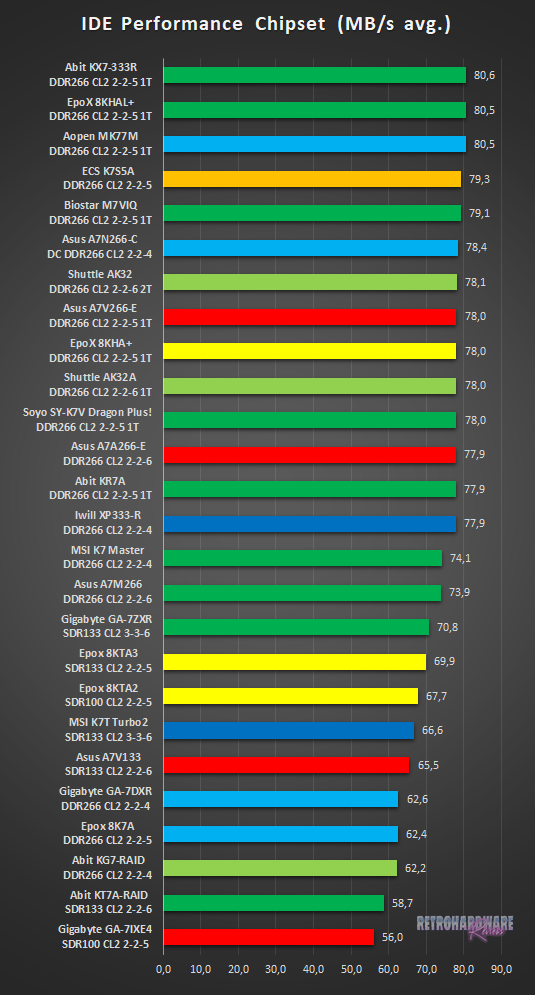
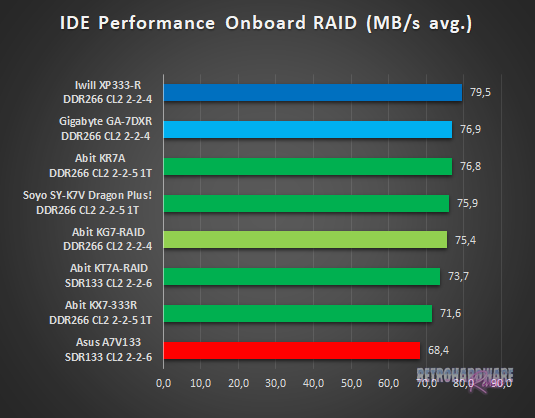
The lowest transfer rates come from the early SDR-only chipsets (AMD750 and KT133/A) and some of the AMD760 based boards. Most of the boards achieve only transfer rates of less than 70 MB/s, the worst performing boards (KT7A-RAID and GA-7IXE4) even stay below 60 MB/s. The K7 Master and the Asus A7M266 achieve a good result of around 74 MB/s, despite the old AMD760 chipset.
Above these, we find the boards with the newer VIA chipsets from KT266 up, as well as the boards with the SiS 735 and ALi MAGiK 1 chipsets. These boards achieve transfer rates between 77,9 and 80,6 MB/s.
In terms of onboard RAID chips, the IWill with its Highpoint ATA133 RAID controller achieves the fastest transfer rate. With very similar results for the southbridge-provided IDE ports, it's a good choice for fast IDE-based storage.
The Abit KR7A-RAID and KX7-333R are slower in the test, although they feature the same Highpoint chip. The Abit KT333 board disappoints in particular, with a result of just 71,6 MB/s. Only the A7V133 with an ATA100 Promise chip is even slower with only just over 68 MB/s.
Gaming Benchmarks
Now that we got all the theoretical performance numbers, let's see how the contenders perform in 3D gaming benchmarks.
3D Performance: 3DMark99max
3DMark99max was released in early 1999 and comes without support for Hardware TnL. The maximum supported (hardware-) DirectX level is DX6. It is a great benchmark to reveal good overall system performance, as it rewards good memory bandwidth and latency more than the slight clockspeed advantage, that some boards have because of their factory-overclocked FSBs.
- Version: "latest"
- Settings: standard
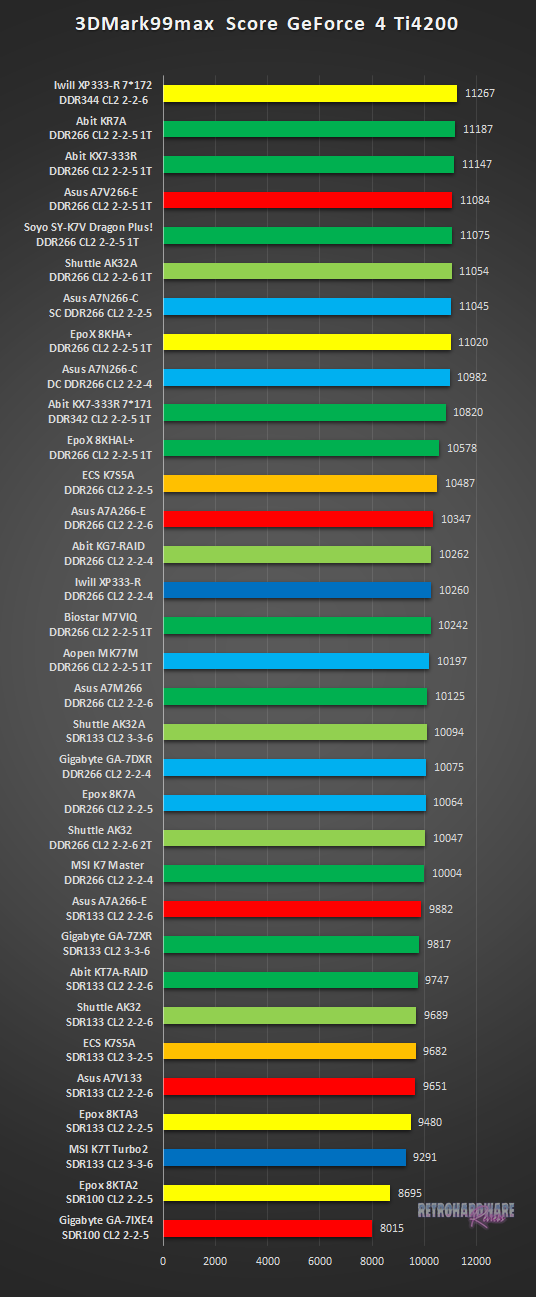
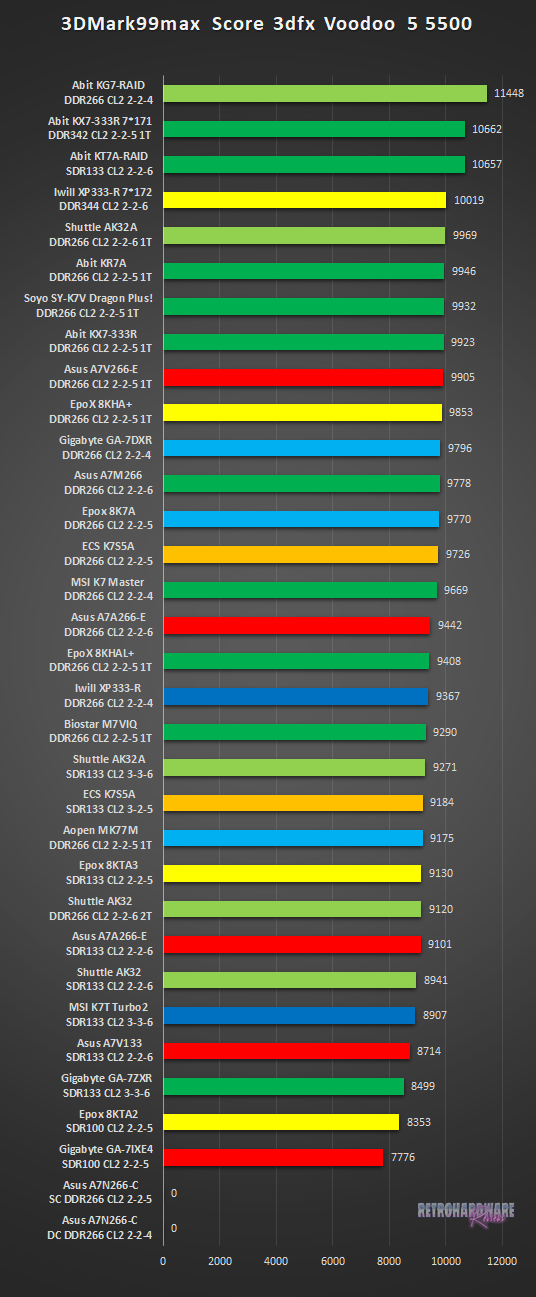
Note: The Abit KX7-333R was unstable with FSB171 in combination with the GeForce 4 in 3DMark99max as well as 3DMark2000, so AGP speed had to be downgraded to 2x.
The FSB-overclocked IWill XP333-R takes first place, closely beating Abit's KR7A-RAID and KX7-333R (in its FSB133 run). It is interesting to see, that Abit's KT266A board is actually a little bit faster than its successor.
All the KT266A boards, except of the EpoX 8KHAL+, as well as the nForce based A7N266-C also achieve good results of around or slightly over 11000 3DMarks. The aforementioned EpoX board is around the performance of the K7S5A and the fastest ALi MAGiK and AMD760 based boards, scoring just under 10600 3DMarks.
Around the 10000 points mark, we find several AMD760, KM266 and KT266 based boards; below that are the boards based on the SDR-only chipsets, as well as the SDR results of the AK32, K7S5A and the A7A266-E. The GA-7ZXR and the KT7A-RAID show a good performance here, as they can beat the SDR results of some boards with newer chipsets.
In the Voodoo 5 run of 3DMark99max, we have two literally unbelievable results in the top three. The KT7A-RAID scores the same as the KT333-based, FSB-overclocked KX7-333R, and the Abit KG7-RAID even scores ~800 points higher and takes first place. As I mentioned in the respective reviews of these two boards, these scores are actually too high for what the boards should be able to achieve, but they are repeatable. The bench looks normal during the run and the results were always in the range of the value I first measured. I just can't explain and/or imagine why that is.
Behind the three Abit boards, we find the FSB-overclocked IWill XP-333R at around 10000 3DMarks, closely ahead of several KT266A based boards. In the ~9700 to ~10000 3DMarks range, there are primarily boards with the VIA KT266A and AMD760 chipset. Furthermore, we have the ECS K7S5A at the lower end of this range, as well as the FSB133 result of the KX7-333R, which scores slightly lower than three of the KT266A boards in the test, including its own predecessor again.
The performance of the AMD760-based boards is truly amazing considering that this was the chipset that introduced DDR memory to the platform. All boards with this chipset can beat every single ALi MAGiK 1, KT266 and KM266 based board in the test, as well as the EpoX 8KHAL+, which is representative of a poorly optimized KT266A based board. Even the SiS735-based K7S5A is outperformed by all but one of the boards with AMD's own DDR chipset.
Among the SDR memory results on the lower end, the EpoX 8KTA3 fares quite good in comparison. It slightly beats the KT266 based Shuttle AK32 in its DDR memory run and shows performance that is between the newer K7S5A and A7A266-E in their respective SDR memory runs.
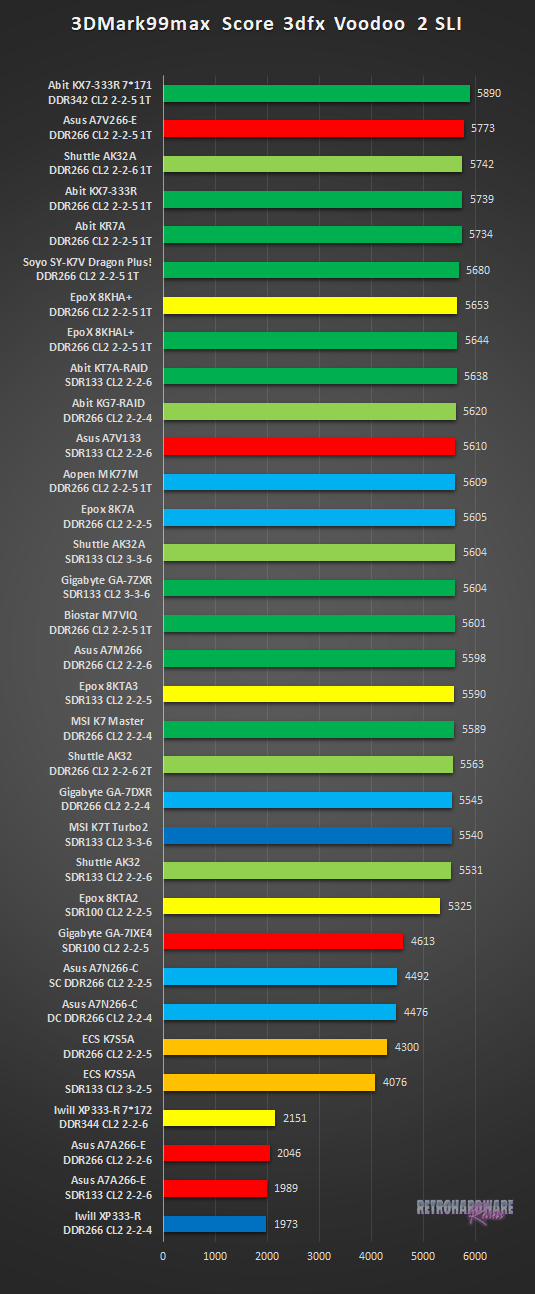
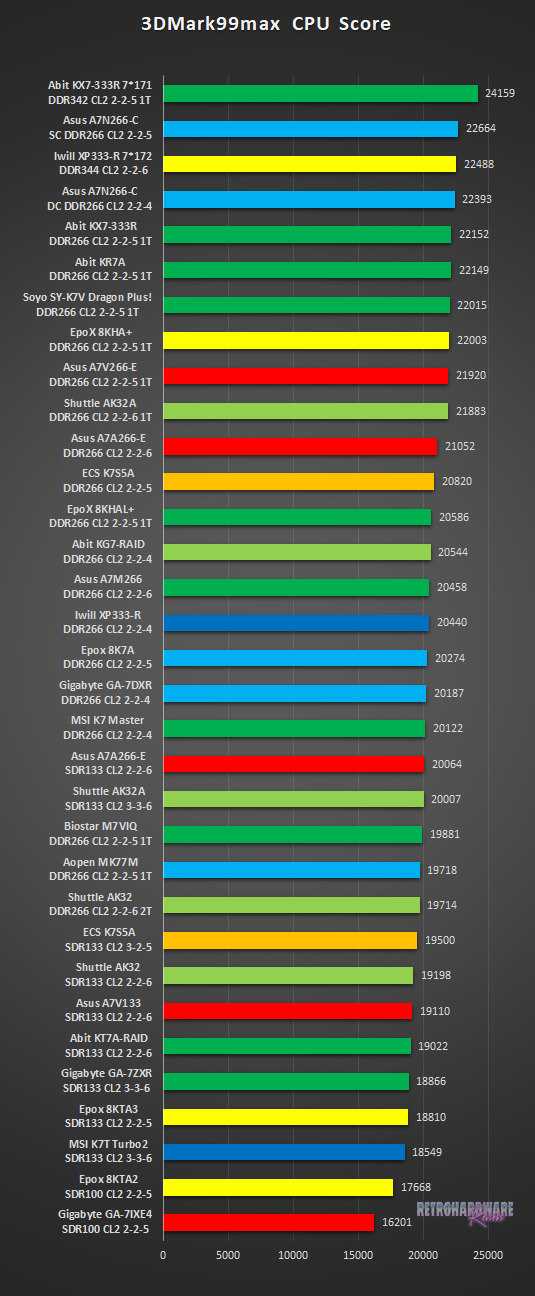
The FSB-overclocked Abit KX7-333R takes first place, just over a hundred points ahead of the A7V266-E in second place. Overall, the results for the Voodoo 2 run are relatively close for most boards, except for those who seem to have issues with the 3dfx cards. With the Abit KT7A-RAID, there is even a SDR-only board among the top ten boards.
The worst results come from the ALi MAGiK based boards from Asus and IWill. These score far less then half of what the well running boards can achieve and obviously have serious issues with the Voodoo 2 cards. The nForce, SiS735 and AMD750 based boards in this test already score twice as high or more, but are nevertheless significantly slower than all of the boards based on any of the VIA chipsets or those with the AMD760.
Abit's KT333 board also takes first place in terms of CPU score, with over 24000 CPU Marks in its FSB171 run. At 133 MHz FSB, it basically performs identical to the Abit KR7A-RAID, which takes sixth place as the fastest KT266A board. Between these results, the Asus A7N266-C in both memory configurations and the FSB-overclocked XP333-R rank second to fourth.
Behind the pack of KT266A boards trailing the KR7A-RAID, there is a little gap of around 800 points. The Asus A7A266-E and the K7S5A are the boards following, which themselves are being trailed by a large group of boards, primarily based on the AM760 chipset.
Below 20000 points, we mainly find boards based on the AMD750 and VIA KT133/A chipsets, as well as the SDR results of some boards with newer chipsets. The results of all KT266 and KM266 based boards are also in this range and those even show worse performance than the Shuttle AK32A and A7A266-E with their respective results in their SDR memory runs.
3D Performance: Unreal Tournament (UT99) Timedemo(s)
Unreal Tournament (UT99) was released in November 1999 and is notorious for its hunger for CPU power. I chose to use two different timedemos for comparison, of which the utbench.dem timedemo is heavily CPU bound and therefore qualifies to measure the general perfomance of the boards. The second timedemo benchmark.dem is as GPU limited as possible in this game. This will reveal, how much impact a faster board can still have in more GPU limited situations. This game is also perfect to show, on which chipsets and boards Voodoo 2 cards run best.
- Version: 4.36
- Settings: High, Min desired Framerate "0", Show Decals [x], Use Dynamic Lightning [x]
- Geforce: D3D
- Voodoo 2 and Voodoo 5: Glide
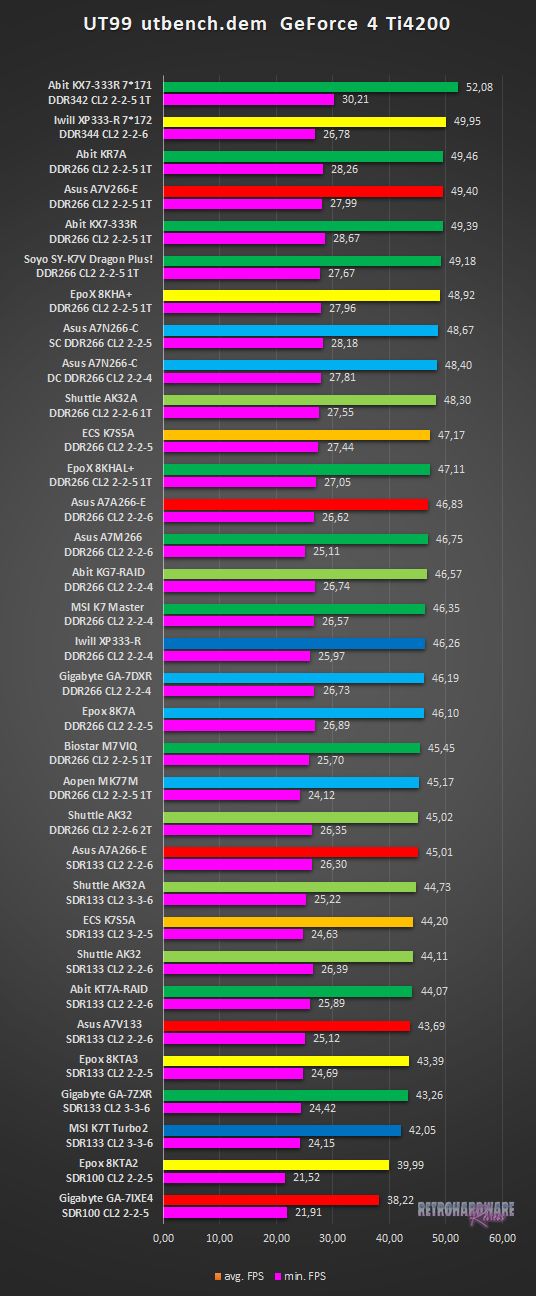
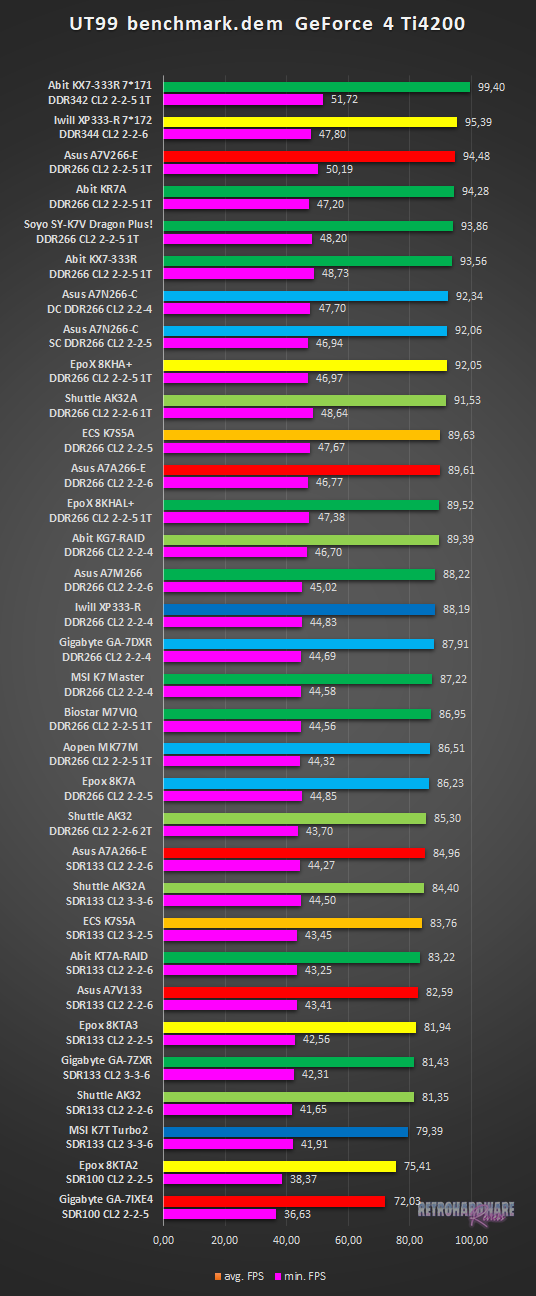
Beginning with the CPU-heavy utbench timedemo, we have the KX7-333R in first place with its FSB171 result, showing noteably better performance in both minimum and average FPS than any other board. At 133 MHz FSB, it is on the level of the fastest KT266A based boards, namely the Abit KR7A-RAID and the Asus A7V266-E. IWill's XP333-R is in second place with slightly higher average FPS than the aforementioned KT266A boards, but its minimum FPS are lower than those of the following 10+ boards.
Behind the top performing boards based on the KT266A/KT333 and nForce chipsets comes a group of boards which achieve around 46-47 FPS on average, led by the K7S5A and the EpoX 8KHAL+, which is the slowest KT266A based board in this timedemo.
The other boards in this group are based on the AMD760 and ALi MAGiK chipsets, which all perform better than the boards based on VIA's KT266 and KM266 chipsets. The latter also achieve pretty low minimum FPS values, especially the AOpen MK77M, which is the third slowest board of all in this regard.
The fastest SDR result comes from the Asus A7A266-E, which achieves impressively high minimum FPS and performs on the level auf the KT266 based AK32 - in its DDR memory run.
It is also interesting to see, how much the CPU performance improved coming from the early FSB100-only chipsets. The two KT133 and AMD750 boards are more then 20% behind the top performing boards.
In the second timedemo, the top performing boards are again the FSB-overclocked KX7-333R and XP333-R, with the Abit board clearly in front. IWill's board is more on the level of the fastest KT266A boards and Abit's KT333 board at 133 MHz FSB, which is around 94-95 FPS on average, with minimum FPS of around 47-48 FPS.
A really interesting result comes from the KG7-RAID. With over 89 FPS on average, it is on the level of the EpoX 8KHAL+, Asus A7A266-E and ECS K7S5A, all of which use newer chipsets. This makes it the best performing AMD760 board by far, especially in terms of minimum FPS.
The slowest board with DDR memory is once again Shuttle's AK32 with the VIA KT266 chipset. At around 85 FPS on average, it is almost 10 FPS behind the fastest KT266A based board and only on the level of the fastest result with SDR memory, coming from the A7A266-E.
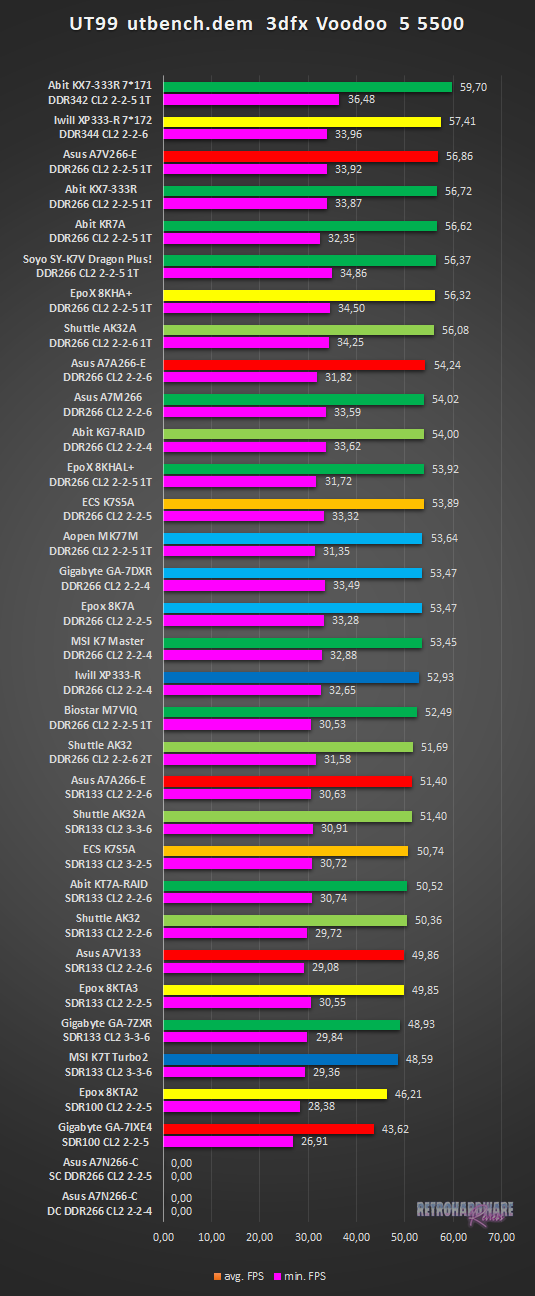
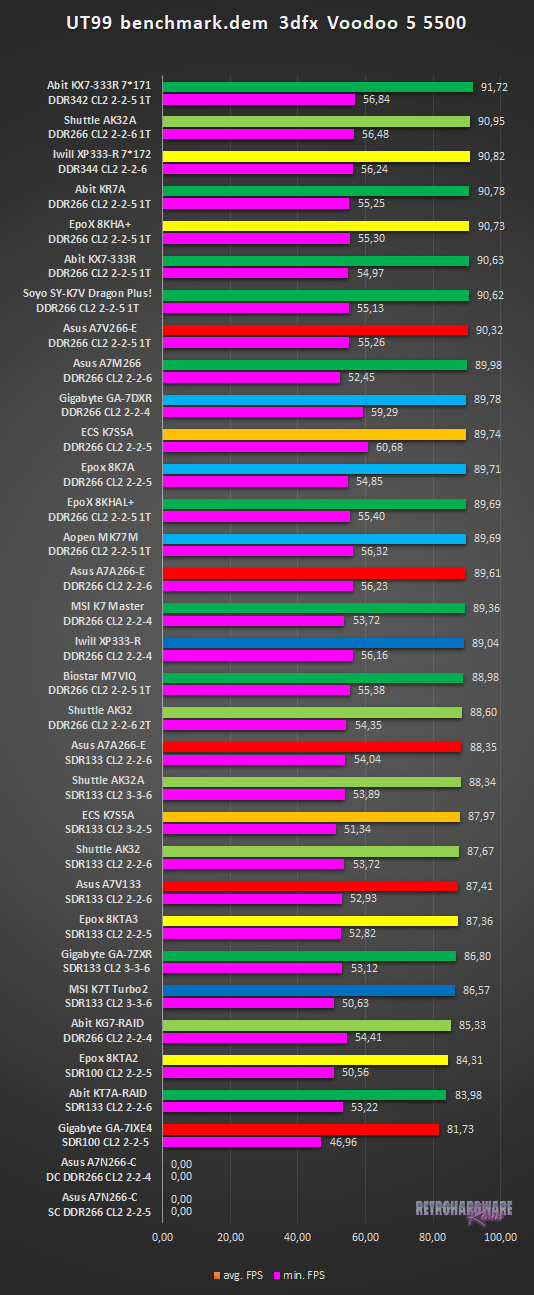
The top two results in the utbench timedemo are once more the FSB-overclocked Abit and IWill boards, with the KX7-333R undisputedly in the lead with almost 60 FPS on average.
Behind these come Abit's KT333 board, as well as all KT266A based boards but the EpoX 8KHAL+ at ~56 to almost 57 FPS. Most of these boards achieve around 34 minimum FPS, the Soyo K7V Dragon Plus! even almost reaches 35 FPS, which is the second best minimum framerate of all boards.
Abit's KR7A-RAID achieves only just over 32 minimum FPS, which is clearly the worst value of the boards on top of the list.
The boards with SiS735, ALi MAGiK and AMD760 chipset, as well as the KT266A based EpoX 8KHAL+ mostly achieve ~53-54 FPS on average. The KG7-RAID, A7M266 and GA-7DXR are also pretty strong in minimum framerate, almost rivaling the KT266A boards in the top group.
The AK32 is the slowest board with DDR memory in the test. The fastest SDR result come from its successor, the Shuttle AK32A with the updated KT266A chipset and the Asus A7A266-E, which both are only slightly slower than the KT266 board.
In the second timedemo, the results for the average framerate are much closer throughout all boards. The difference between the first placed KX7-333R at FSB171 and the GA-7IXE4 at FSB100 in last place is only about 10 FPS.
The boards in front are once more based on the VIA KT266A, aside of the overclocked IWill XP333-R and the Abit KX7-333R in both FSB speeds. Among these, the Shuttle AK32A delivers the most impressive performance, as it beats the overclocked IWill board in both average and minimum FPS and ranks second.
Behind the pack of (mostly) KT266A boards, we have another two results worth mentioning. Both the K7S5A and the GA-7DXR are able to keep the minimum FPS around the 60 FPS mark, which are by far the best results among all boards. Their average FPS are also only about 1 FPS lower than those of the fastest boards.
There are also two less pleasant results to report, at least from Abit's point of view. The results for the KG7-RAID and the KT7A-RAID are significantly lower than those of all the boards based on the respective identical chipsets. Both are among the overall slowest boards, the KT7A-RAID even ranks behind the EpoX 8KTA2, which is based on the FSB100-only KT133 chipset.
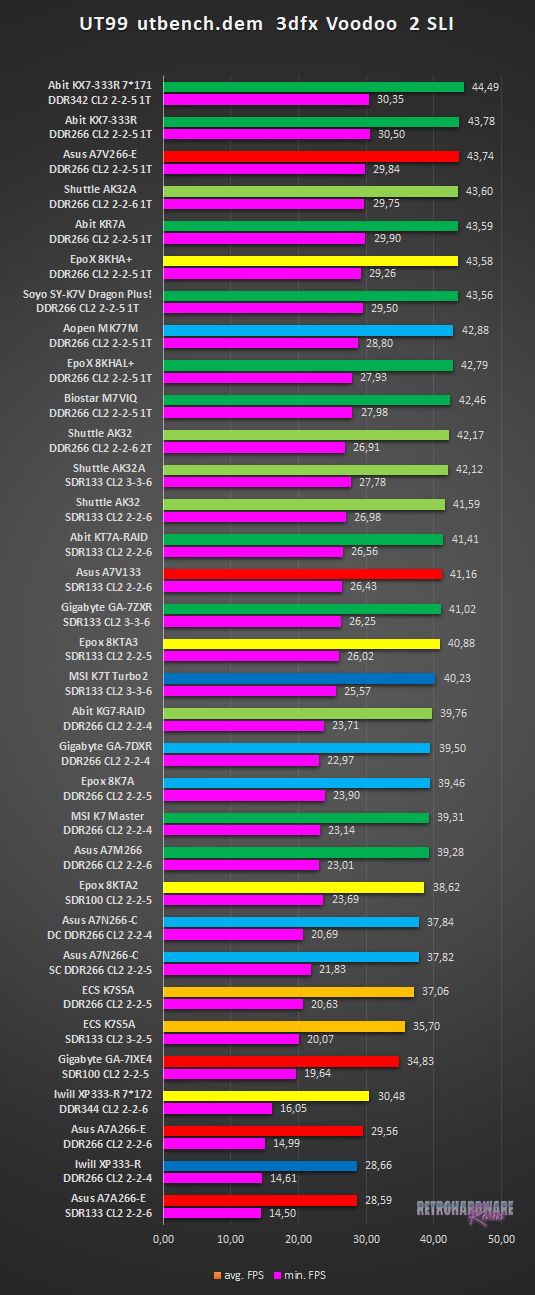
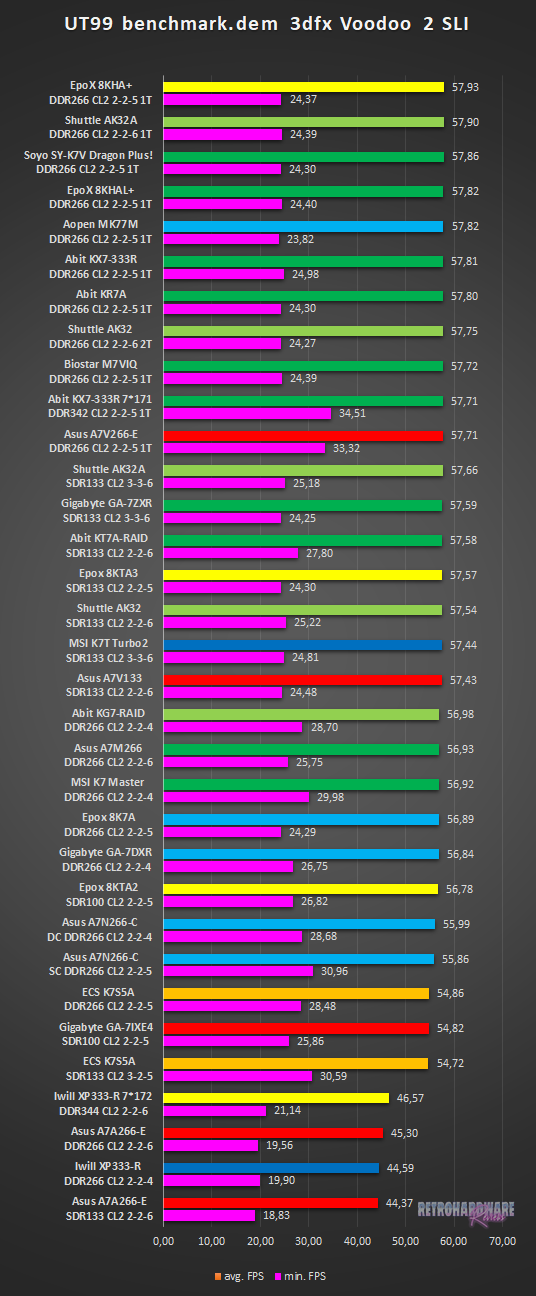
The KX7-333R takes first and second place at 171 and 133 MHz FSB, respectively, and is the only board that can keep the Voodoo 2 cards above 30 FPS at all times in the utbench timedemo. All KT266A based boards, with the exception of the EpoX 8KHAL+, are not far behind in both average and minimum framerates and are the second best option for Voodoo 2 cards in this CPU-heavy test.
VIA chipsets generally seem to be a very good choice. The MSI K7T Turbo2, with the slowest result for a VIA-based motherboard (with FSB133), is still faster than the fastest board with a non-VIA chipset, which is the Abit KG7-RAID. Especially the minimum FPS are much better on the MSI board, even though it only uses SDR memory.
The AMD760 based boards, led by the KG7-RAID, all achieve around ~39 to ~40 FPS on average and ~23 to ~24 FPS of minimum framerate and are only slightly faster than the overall slowest VIA board, the EpoX 8KTA2 with the SDR- and FSB100-only VIA KT133 chipset. The minimum FPS of the EpoX board are totally in the range of the AMD760 boards ahead of it and the average framerate is also only slightly below 39.
Following behind are the nForce, SiS735 and AMD750 based boards, averaging around 35-38FPS, with minimum framerates only in the 20FPS range. Boards with the aforementioned chipsets are not the best choice for Voodoo 2 cards, as they seem to struggle in CPU-limited situations.
Boards with the ALi MAGiK chipset should be avoided alltogether, when Voodoo 2 cards are to be part of the system. All boards with this chipset show very poor performance and are significantly slower than all other boards in this test.
The second timedemo brings a very even set of results to the table. With the exception of the ALi MAGiK-based A7A266-E and XP333-R, all boards achieve an average framerate of ~55 to 58. The difference lies more in the achieved minimum FPS, which is around 24-25 for most of the boards based on one of the VIA chipsets.
Interestingly, the boards with AMD, nVidia and SiS chipsets are mostly a bit stronger in terms of minimum framerate in this timedemo. Especially the KG7-RAID, K7 Master, A7N266-E and K7S5A show a strong performance in this regard and achieve around ~29 to ~31 of minimum framerate.
The overall best minimum framerate by far come from the A7V266-E and the FSB-overclocked Abit KX7-333R, which achieve 33,xx and 34,xx FPS, respectively. The two boards with the ALi MAGiK 1 chipset are once again the slowest with significantly lower minimum and average framerate than all the other boards.
3D Performance: Quake III Arena Timedemo
Quake 3 Arena was released shortly after Unreal Tournament, in December of 1999. It is known to reward fast memory latency and with its normal preset, it is completely CPU limited; at least for the GeForce 4 and the Voodoo 5. The Voodoo 2 SLI cards clearly limit the Athlon 1200 here, but we will see if the cards are able to reach the same level of performance on all chipsets or not (tiny spoiler: they don't 😉 ).
- Version: 1.32
- Settings: “Normal” Preset, only resolution changed to 1024x768x16
- Geforce 5 and Voodoo5: OpenGL
- Voodoo 2: “Voodoo” Renderer (miniGL)
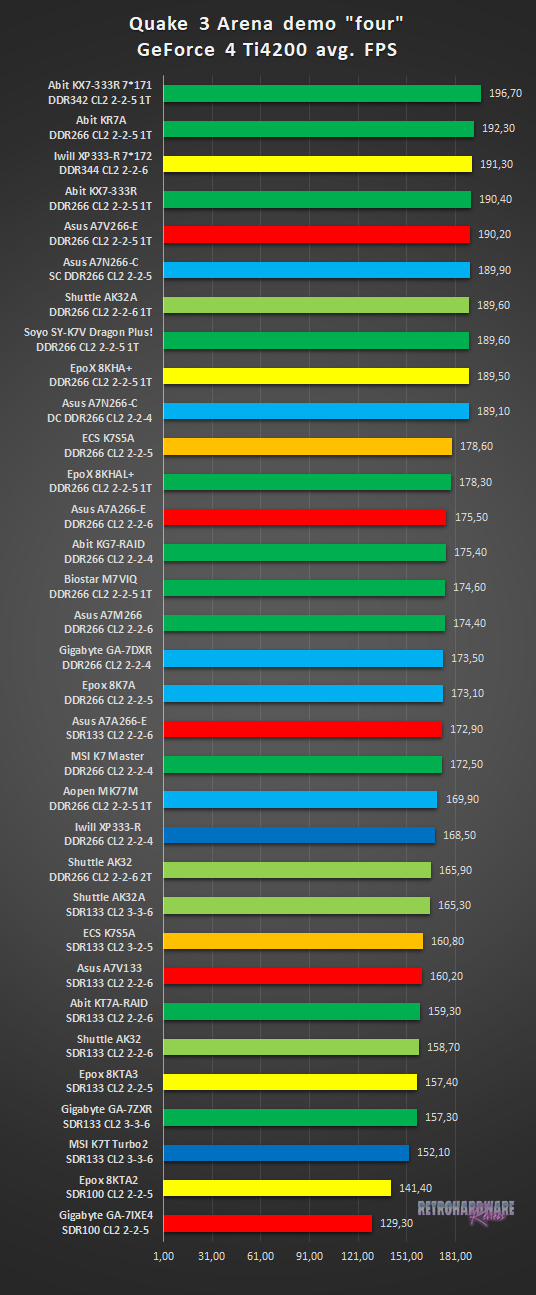
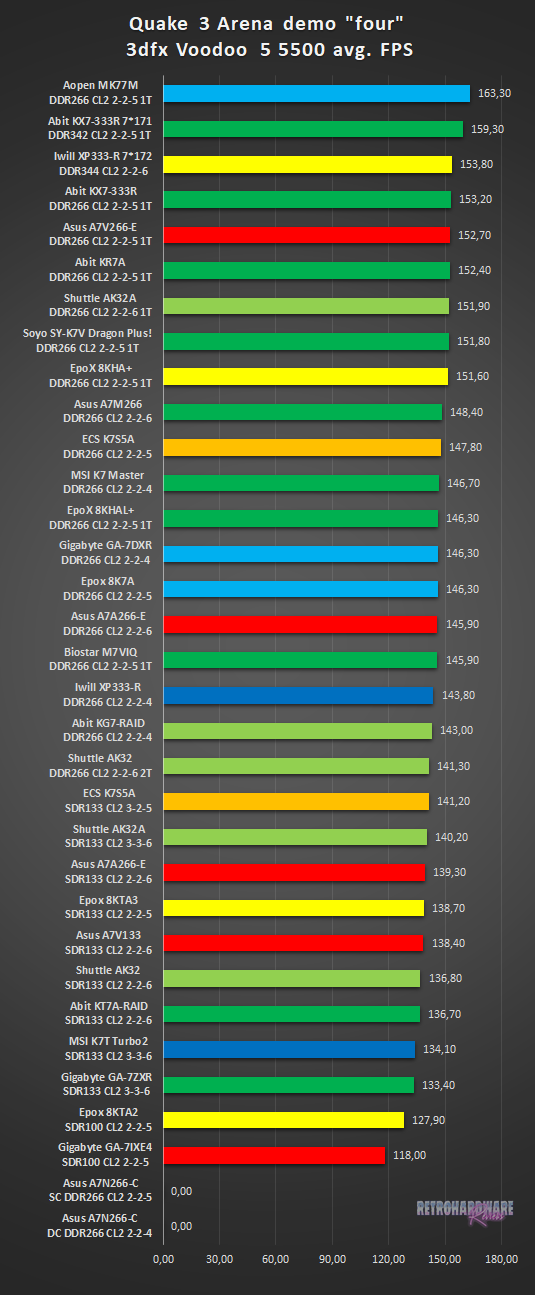
The KT266A-based boards are again by far the fastest in the GeForce Ti run of Quake III Arena, with all but one board hitting ~189 to ~192 FPS in the timedemo. The KR7A-RAID even slightly outperforms the IWill XP333-R in its FSB172 run, as well as the KT333-based KX7-333R at 133 MHz FSB, which take third and fourth place. The fastest overall board is Abit's KX7-333R at 171 MHz FSB, with an average of almost 197 FPS.
The nForce-based A7N266-C is also in the top group in both memory configurations at around 189 to 190 FPS. Following a gap of over 10 FPS, we find the K7S5A and the EpoX budget KT266A board, which perform about the same. The 8KHAL+ is once more by far the slowest board with this chipset.
The midfield in the ~165 to 175 FPS range consists of all the remaining DDR chipset boards, plus the A7A266-E and Shuttle AK32A with their SDR results. This is an impressive outcome for the ALi MAGiK-based Asus board, as it performs in the range of most AMD760 boards and beats several boards with DDR memory, despite its slower SDR memory.
In the Voodoo 5 run of Q3A, the results are a bit closer and we (almost) don't see any significant gaps between the results. The biggest differences are found right at the top of the results, as well as at the bottom of the list.
The top performing board with 3dfx's flagship card is the AOpen MK77M, and I honestly cannot say why that is. All of the board's previous results were average to disappointing, and the theoretical values (AGP bandwidth, memory latency, etc.) also looked rather poor. Probably there was some kind of measurement error ("resolution too low" or something?), so don't read too much into this.
In second place, the KX7-333R at 171 MHz FSB is also well ahead of all other boards, beating the XP333-R in third place at 172 MHz FSB by more than 5 FPS. Behind the IWill board we have the KX7-333R at 133 MHz FSB, as well as several KT266A-based boards within about 2 FPS.
The midfield is similar to that of the GeForce 4 Ti run, only this time the K7S5A and EpoX 8KHAL+ are caught up by the AMD760 boards. This excludes the Abit KG7-RAID, which only "leads" the bottom third of results as the second slowest board with DDR memory.
The only slower board is the KT266-based Shuttle AK32, which is only on the level of the fastest SDR-based result, coming from Elitegroup's K7S5A. At the bottom of the list we have our FSB100-only boards from EpoX and Gigabyte, with the latter being over 25% slower than the top performers (even excluding all FSB overclocked results as well as the MK77M). This is an astonishing result, considering that all the boards have the CPU running at basically the same speed, and clearly shows the development that Socket A went through in the early days.
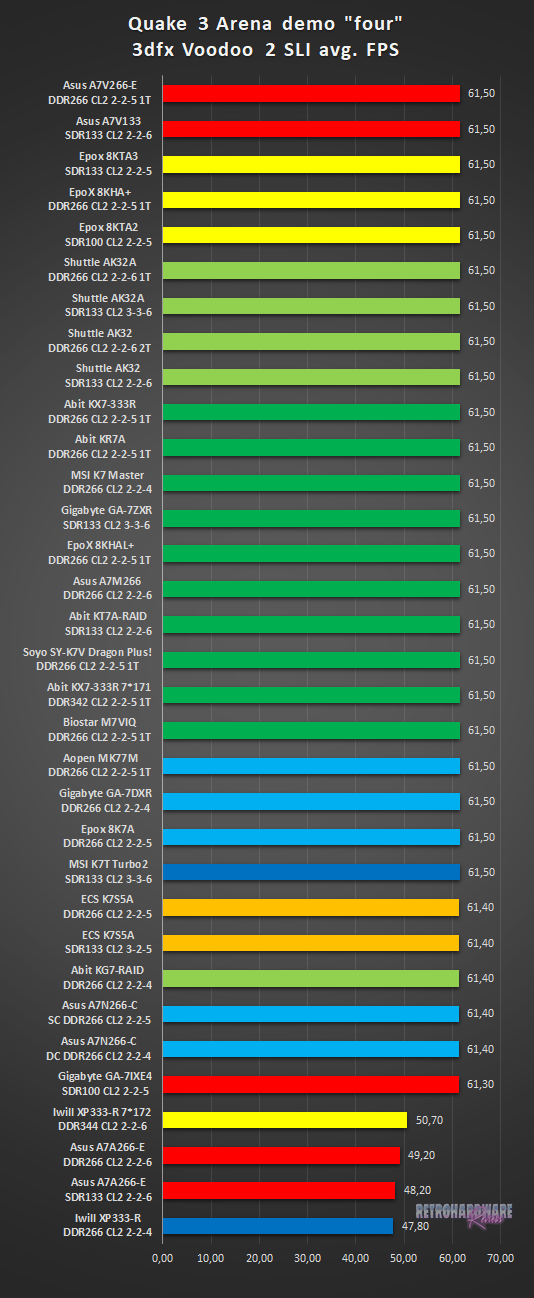
Despite the extremely CPU-heavy setting for the benchmark, the Voodoo 2 cards obviously reach their limits here. Only the ALi MAGiK-based boards from Asus and IWill prove once again that they should not be combined with these cards, as they are around 20% behind the performance of the competition based on VIA, AMD, SiS and nVidia chipsets. The remaining boards are able to push the Voodoo 2 cards to their limits, reaching an average of 61,50 to 61,30 FPS.
Ranking: Boards & Chipsets
After all these isolated rankings, let's combine the results and have a look how the boards with the same chipsets compare to each other (for the most common ones) and which chipsets are best suited for the respective 3D chips / cards.
In order to do that, I calculated the average FPS of all UT99 and Q3A timedemo values for the respective 3D chipsets, as well as a weighted average for each board for all 3D cards combined.
Since the Voodoo 5 and Geforce 4 Ti produced relatively comparable results, I multiplied the Voodoo 2 results with 1,75 to get these in the same FPS range as the other chipsets. This has three effects:
- The weighted average result is around the level the boards achieved with the two stronger 3D cards (for boards who didn't show problems with the Voodoo 2 cards)
- Boards that don't run well with Voodoo 2 cards, are punished for this and can't even these results out too easily with their faster Voodoo 5 and Geforce 4 Ti runs
- These boards are easily found in the total ranking, as the bars for the GeForce 4 Ti and Voodoo 5 runs are both longer than the bar for the weighted average
For those interested in mathematics, and for clarity in general, this is the formula for the "weighted average":
(((G4 utbench avg + G4 utbench min + G4 benchmark avg + G4 benchmark min + G4 Q3A four)/5) + ((V5 utbench avg + V5 utbench min + V5 benchmark avg + V5 benchmark min + V5 Q3A four)/5) + ((V2 utbench avg + V2 utbench min + V2 benchmark avg + V2 benchmark min + V2 Q3A four)/5*1,75))/3
With that out of the way, let's get to the combined results!
Ranking: Boards with the VIA KT133A chipset
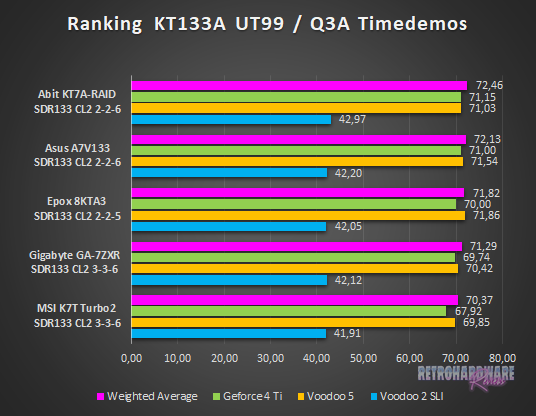
The differences between the boards may not be dramatic, but they do exist. The Abit KT7A-RAID is a very good choice for Voodoo 2 cards and is also the fastest board with the GeForce 4. The EpoX 8KTA3 is the best choice for a Voodoo 5 and the A7V133 performs well overall, ranking second for all of the cards.
Ranking: Boards with the AMD760 chipset
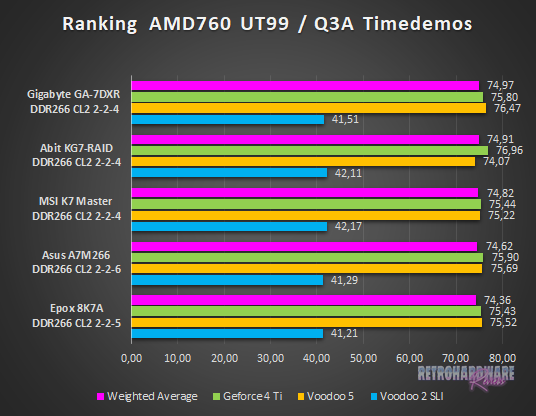
The performance of the AMD760 boards is much more similar than previously seen in the results for the KT133A-based boards. The Gigabyte GA-7DXR performs best with the Voodoo 5, the GeForce 4 Ti runs best on the Abit board. The Voodoo 2 boards are ideally combined with the KG7-RAID or the MSI K7 Master. But the performance differences are really small, any AMD760-based board is a solid choice.
Ranking: Boards with the VIA KT266A chipset
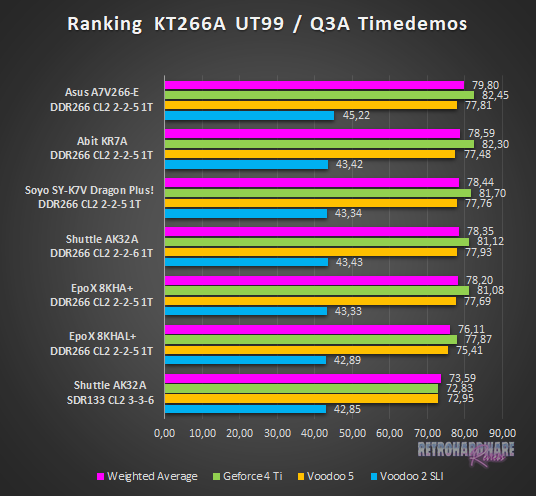
With the exception of the EpoX 8KHAL+ and the SDR result of the Shuttle AK32A, the results are very close. The boards from Asus and Abit have a small advantage with the GeForce 4 Ti, and the A7V266-E is the undisputed king of Voodoo 2 SLI performance. Other than that, the top five boards don't differ too much.
Ranking: Boards with SDR memory
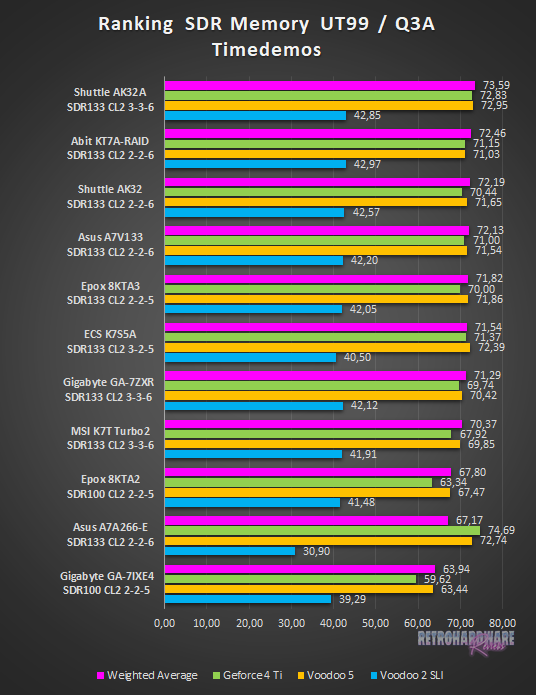
The KT266A based AK32A achieves first place overall, which is exactly what I would have said if asked before doing all the benches. But I expected it to dominate all the other SDR based boards, which did not happen. For example, the A7A266-E is much faster with the GeForce 4 Ti (even faster than some boards with DDR RAM) and also nearly matches the performance of the Shuttle board with the Voodoo 5. If the Asus board wouldn't show such catastrophic Voodoo 2 performance, it would surely be in first place instead.
The K7S5A also suffers from its sub-optimal Voodoo 2 performance. It ranks behind some KT133A boards, as well as the KT266 based AK32, although its performance with the GeForce 4 Ti and the Voodoo 5 is better than the boards ahead of it (excluding the AK32A).
Chipset Performance by Release Date
In this little overview I want to visualize, how the performance of the platform developed in its early days, with the introduction of newer chipsets.
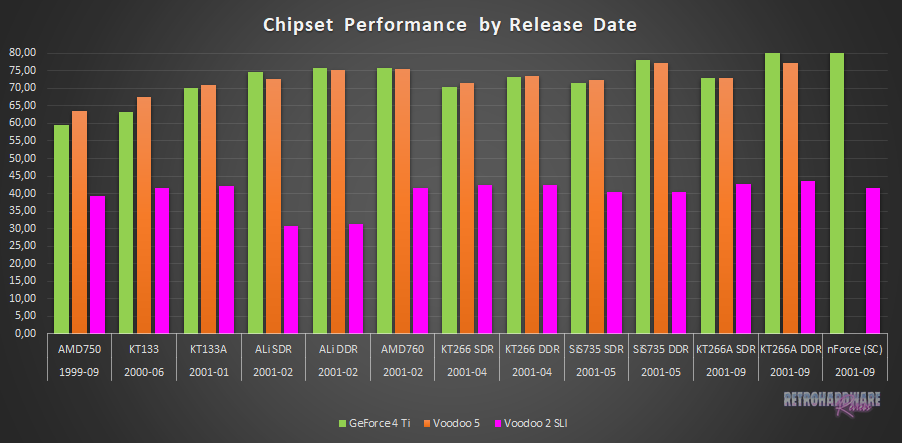
The performance gain over time is nicely visibile, especially in the beginning. VIA's KT266 chipset is easily identified as a failure, as it is the only chipset which can't at least match the performance of the chipsets launched before it. Another thing visible is, how litte performance the ALi MAGiK chipset loses when using SDR instead of DDR memory. Its GeForce 4 Ti performance in particular, is almost identical with both types of memory.
Chipset Performance Overview: GeForce 4 Ti and Voodoo 2 SLI
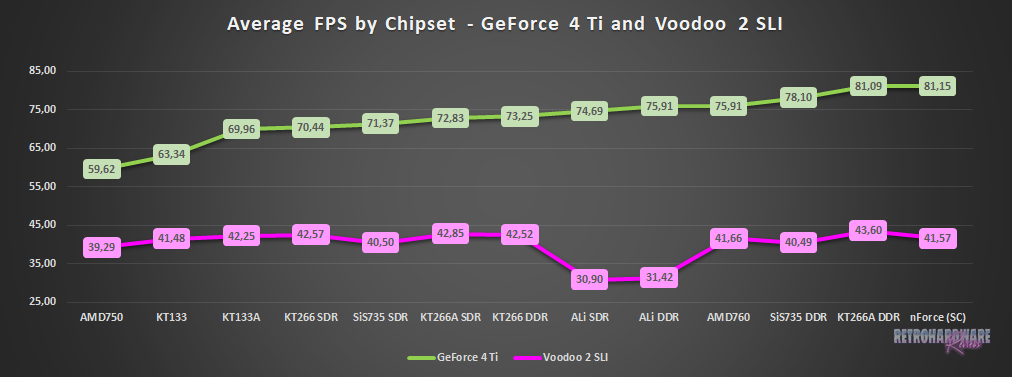
The combination of a GeForce 4 Ti and a pair of Voodoo 2 cards is one of the best for a Windows 9x Retromachine in terms of compatibility and performance.
The best Socket A chipset for such a setup is without a doubt the VIA KT266A. Its GeForce 4 Ti performance is on a par with the first-placed nForce chipset, and it is also clearly the fastest chipset for Voodoo 2 cards. VIA chipsets in general work very well with these, with the KT133A and up showing better Voodoo 2 performance than any other chipset from ALi, AMD, nVidia and SiS. Even VIA's very first Socket A chipset, the KT133, is comparable in Voodoo 2 performance to the AMD760 and nVidia nForce chipsets.
However, both the KT133 and the AMD750 perform poorly with the GeForce 4 Ti and cannot be recommended for such a setup. ALi MAGiK based boards should also be avoided, as the Voodoo 2 cards are unacceptably slow with this chipset. All other chipsets are valid options.
Chipset Performance Overview: Voodoo 5 5500
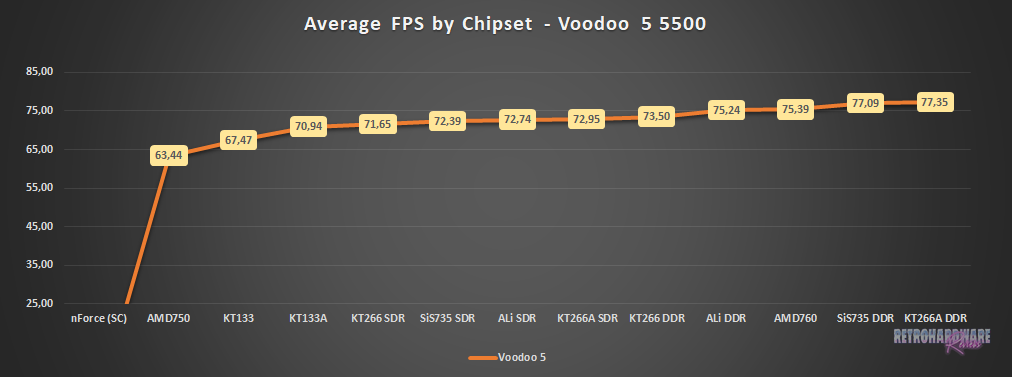
The Voodoo 5 is less demanding (/more efficient) than the GeForce 4 Ti and thus runs better on less powerful systems. In fact, all chipsets with SDR memory (except the ALi MAGiK 1 ) run faster with the Voodoo 5 than with the GeForce 4 Ti.
Nevertheless, the early SDR chipsets (AMD750 and KT133) are not the best choice for a Voodoo 5 system, as the performance of the newer DDR chipsets is still significantly higher and the platform has matured with each new chipset.
The fastest options for building a Voodoo 5 system are boards with the VIA KT266A and SiS735 chipsets, boards with AMD760 and ALi MAGiK 1 chipsets are also well suited.
Complete Ranking: Boards
I don't think I need to write too much about this. As a closure to this roundup, here is an overview of all the averages from all the boards, condensed into one big ranking. Have fun =)







awesome so much work put into this. I always get nauseated from the typical epox kt333 recommendation for the v5. at that point your chasing benchmarks lol yet i run p4 with v5. anyway the only thing i wish is more people use deus ex and expendable esp if its amd focused as well. otherwise great work and thank you.
Hey, thank you very much for your comment! It means a lot to me knowing the content is read and appreciated.
Expendable will most certainly be part of future benchmarks / comparisons. As for Deus Ex: I‘ve never seen it as a benchmarking option, has it an integrated timedemo or do you know a good one for download? Is it as CPU heavy as UT or heavier on the GPU? I‘ll definitely check it as an option, thank you for the input!
By the way – I also used a socket 478 system with SiS645DX chipset for my Voodoo 5 6000 for several years. Also a very powerful platform.